International Economic Analysis: McDonald's Business in New Zealand
VerifiedAdded on 2023/01/13
|12
|2437
|47
Report
AI Summary
This report presents a comprehensive industry analysis of McDonald's operations, focusing on its business in New Zealand. It begins with an executive summary, followed by an introduction outlining McDonald's vision, mission, organizational structure, and target customers. The core of the report evaluates McDonald's business processes, including marketing strategies, quality management, and supply chain practices. A detailed industry analysis is conducted using SWOT, Porter's Five Forces, PEST, and asset analysis to assess the company's strengths, weaknesses, opportunities, and threats within the competitive landscape. The report also examines the bargaining power of customers and suppliers, competitive rivalry, and the threat of new entrants and substitutes. Finally, the report concludes with recommendations for McDonald's, including improvements to marketing, customer service, and menu customization, as well as an integrated promotional mix.
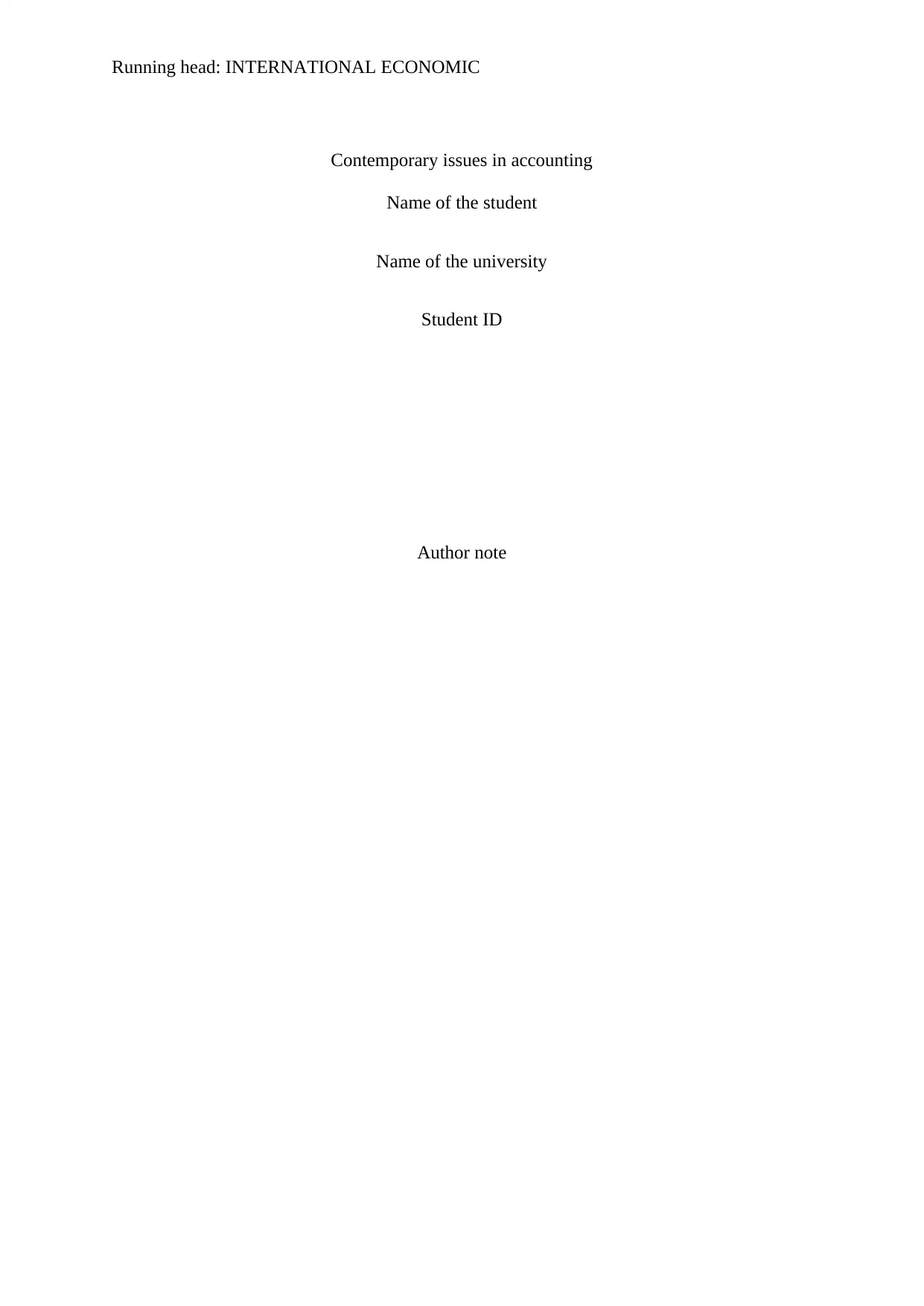
Running head: INTERNATIONAL ECONOMIC
Contemporary issues in accounting
Name of the student
Name of the university
Student ID
Author note
Contemporary issues in accounting
Name of the student
Name of the university
Student ID
Author note
Paraphrase This Document
Need a fresh take? Get an instant paraphrase of this document with our AI Paraphraser
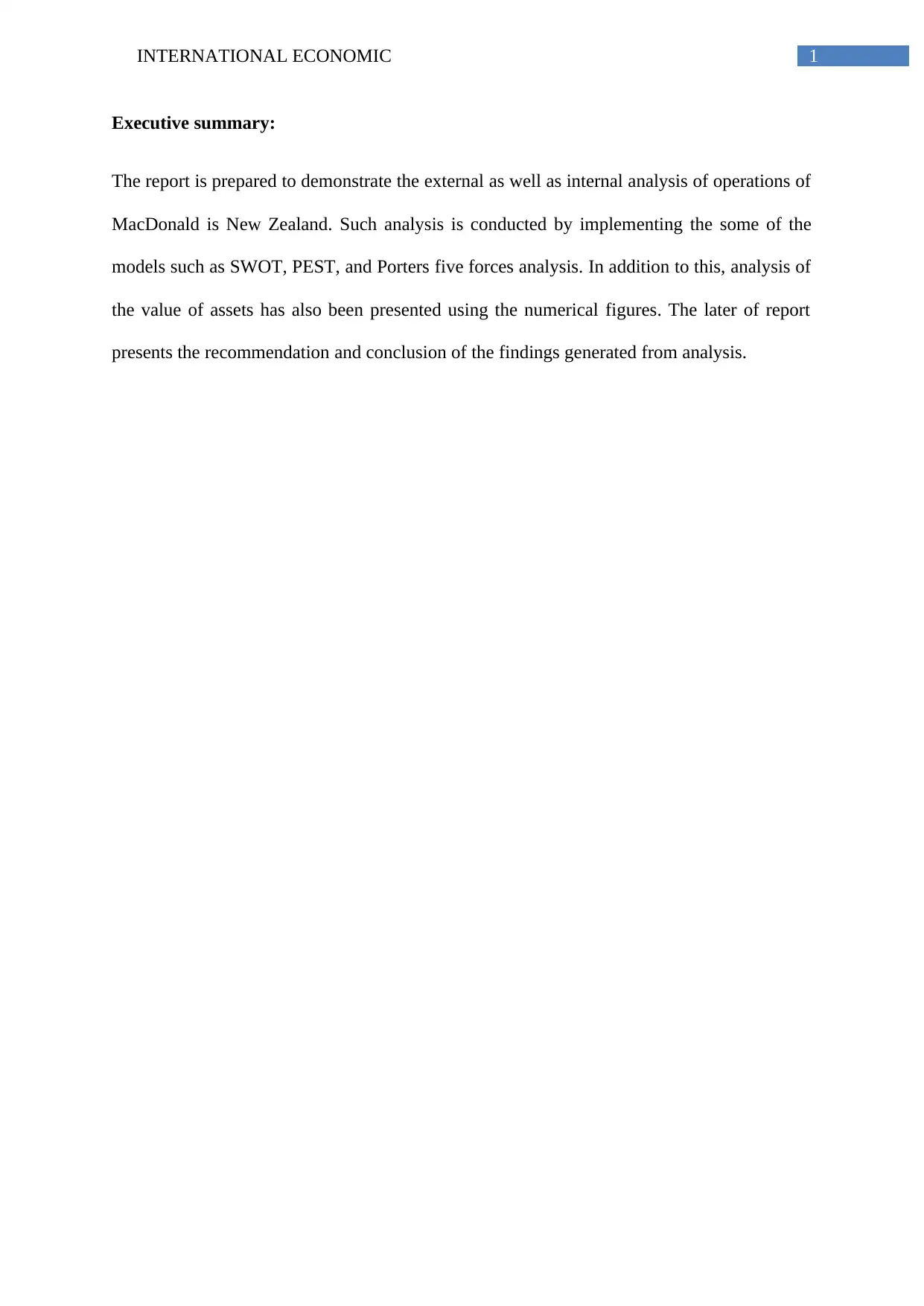
1INTERNATIONAL ECONOMIC
Executive summary:
The report is prepared to demonstrate the external as well as internal analysis of operations of
MacDonald is New Zealand. Such analysis is conducted by implementing the some of the
models such as SWOT, PEST, and Porters five forces analysis. In addition to this, analysis of
the value of assets has also been presented using the numerical figures. The later of report
presents the recommendation and conclusion of the findings generated from analysis.
Executive summary:
The report is prepared to demonstrate the external as well as internal analysis of operations of
MacDonald is New Zealand. Such analysis is conducted by implementing the some of the
models such as SWOT, PEST, and Porters five forces analysis. In addition to this, analysis of
the value of assets has also been presented using the numerical figures. The later of report
presents the recommendation and conclusion of the findings generated from analysis.
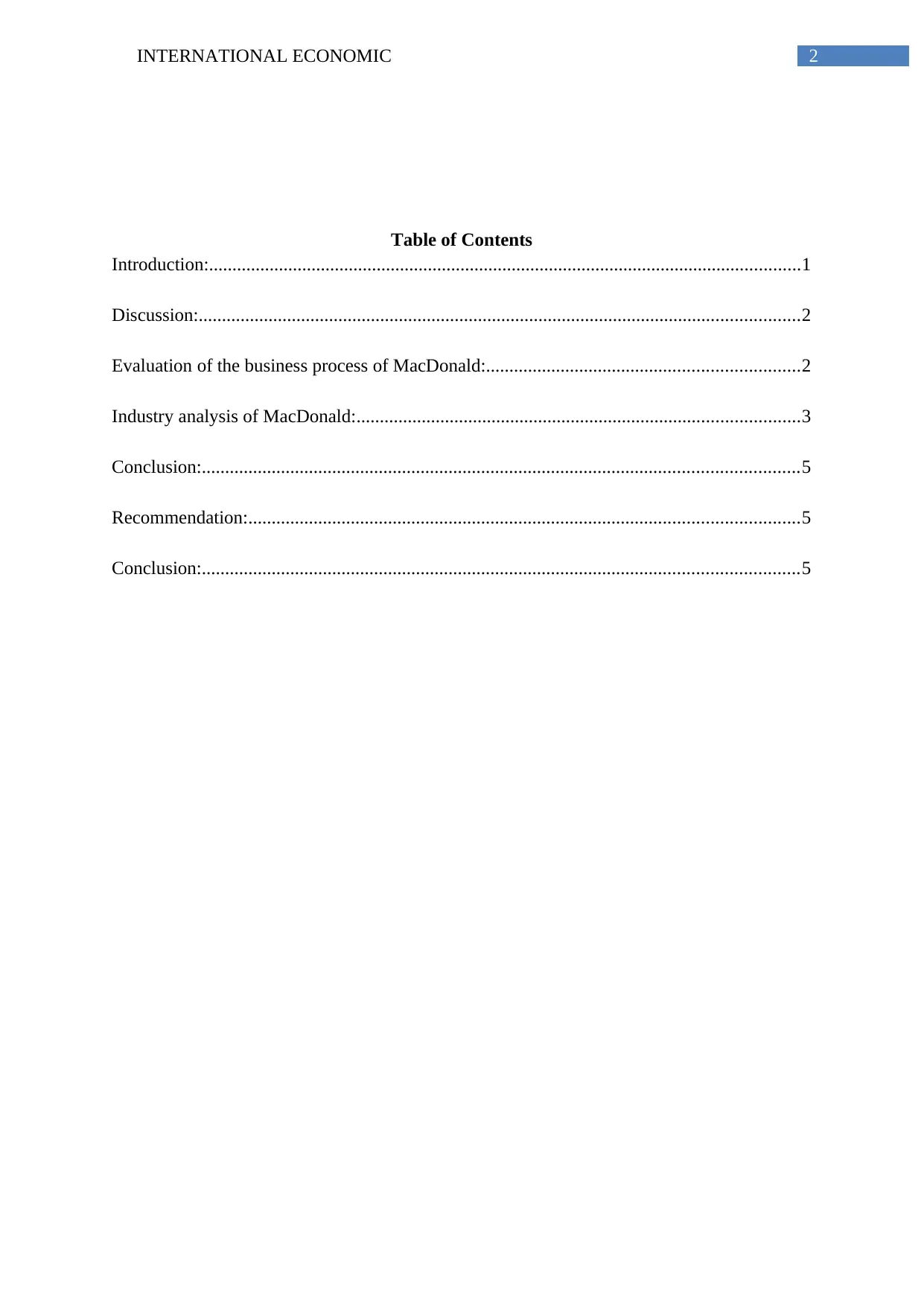
2INTERNATIONAL ECONOMIC
Table of Contents
Introduction:...............................................................................................................................1
Discussion:.................................................................................................................................2
Evaluation of the business process of MacDonald:...................................................................2
Industry analysis of MacDonald:...............................................................................................3
Conclusion:................................................................................................................................5
Recommendation:......................................................................................................................5
Conclusion:................................................................................................................................5
Table of Contents
Introduction:...............................................................................................................................1
Discussion:.................................................................................................................................2
Evaluation of the business process of MacDonald:...................................................................2
Industry analysis of MacDonald:...............................................................................................3
Conclusion:................................................................................................................................5
Recommendation:......................................................................................................................5
Conclusion:................................................................................................................................5
You're viewing a preview
Unlock full access by subscribing today!
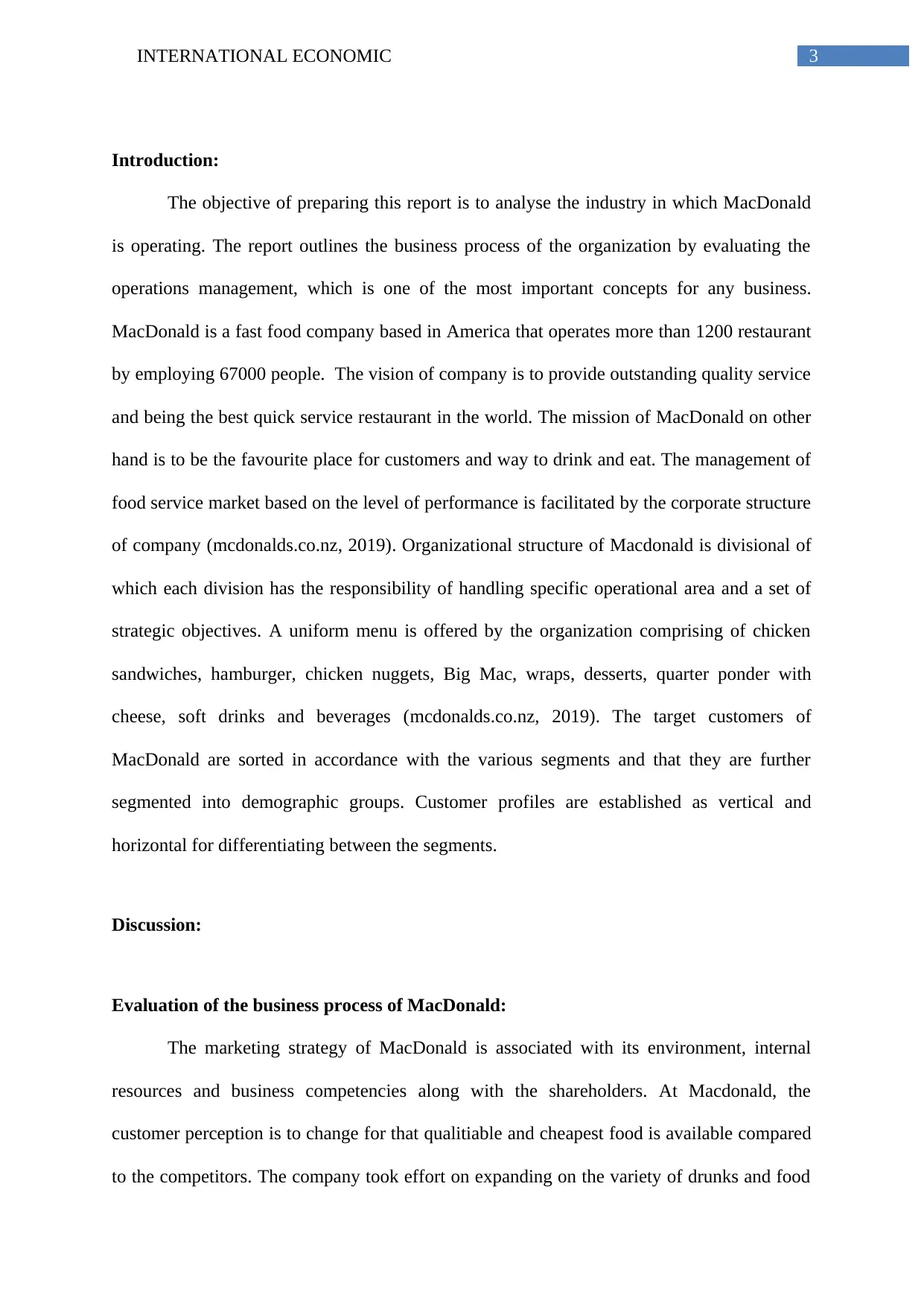
3INTERNATIONAL ECONOMIC
Introduction:
The objective of preparing this report is to analyse the industry in which MacDonald
is operating. The report outlines the business process of the organization by evaluating the
operations management, which is one of the most important concepts for any business.
MacDonald is a fast food company based in America that operates more than 1200 restaurant
by employing 67000 people. The vision of company is to provide outstanding quality service
and being the best quick service restaurant in the world. The mission of MacDonald on other
hand is to be the favourite place for customers and way to drink and eat. The management of
food service market based on the level of performance is facilitated by the corporate structure
of company (mcdonalds.co.nz, 2019). Organizational structure of Macdonald is divisional of
which each division has the responsibility of handling specific operational area and a set of
strategic objectives. A uniform menu is offered by the organization comprising of chicken
sandwiches, hamburger, chicken nuggets, Big Mac, wraps, desserts, quarter ponder with
cheese, soft drinks and beverages (mcdonalds.co.nz, 2019). The target customers of
MacDonald are sorted in accordance with the various segments and that they are further
segmented into demographic groups. Customer profiles are established as vertical and
horizontal for differentiating between the segments.
Discussion:
Evaluation of the business process of MacDonald:
The marketing strategy of MacDonald is associated with its environment, internal
resources and business competencies along with the shareholders. At Macdonald, the
customer perception is to change for that qualitiable and cheapest food is available compared
to the competitors. The company took effort on expanding on the variety of drunks and food
Introduction:
The objective of preparing this report is to analyse the industry in which MacDonald
is operating. The report outlines the business process of the organization by evaluating the
operations management, which is one of the most important concepts for any business.
MacDonald is a fast food company based in America that operates more than 1200 restaurant
by employing 67000 people. The vision of company is to provide outstanding quality service
and being the best quick service restaurant in the world. The mission of MacDonald on other
hand is to be the favourite place for customers and way to drink and eat. The management of
food service market based on the level of performance is facilitated by the corporate structure
of company (mcdonalds.co.nz, 2019). Organizational structure of Macdonald is divisional of
which each division has the responsibility of handling specific operational area and a set of
strategic objectives. A uniform menu is offered by the organization comprising of chicken
sandwiches, hamburger, chicken nuggets, Big Mac, wraps, desserts, quarter ponder with
cheese, soft drinks and beverages (mcdonalds.co.nz, 2019). The target customers of
MacDonald are sorted in accordance with the various segments and that they are further
segmented into demographic groups. Customer profiles are established as vertical and
horizontal for differentiating between the segments.
Discussion:
Evaluation of the business process of MacDonald:
The marketing strategy of MacDonald is associated with its environment, internal
resources and business competencies along with the shareholders. At Macdonald, the
customer perception is to change for that qualitiable and cheapest food is available compared
to the competitors. The company took effort on expanding on the variety of drunks and food
Paraphrase This Document
Need a fresh take? Get an instant paraphrase of this document with our AI Paraphraser
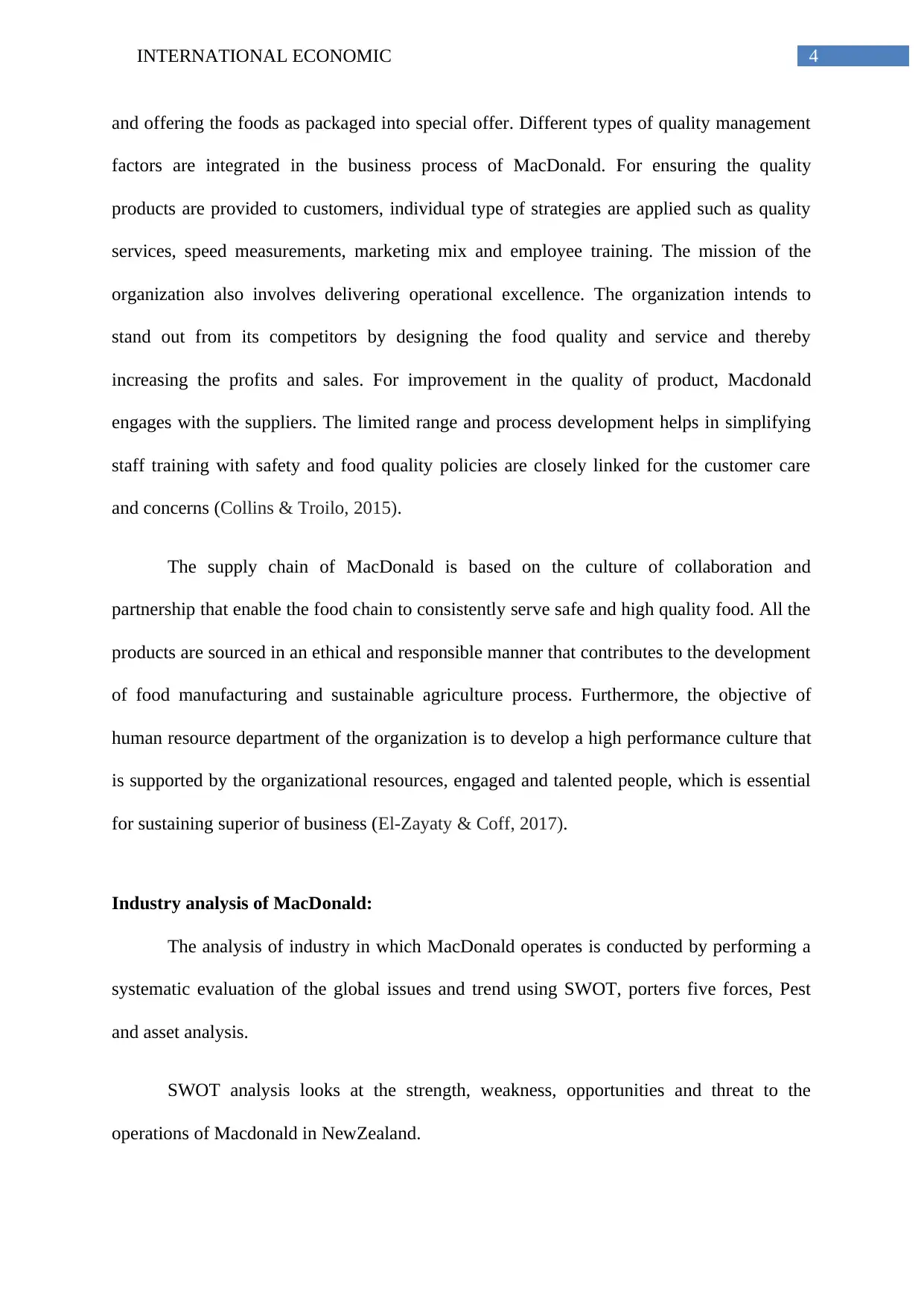
4INTERNATIONAL ECONOMIC
and offering the foods as packaged into special offer. Different types of quality management
factors are integrated in the business process of MacDonald. For ensuring the quality
products are provided to customers, individual type of strategies are applied such as quality
services, speed measurements, marketing mix and employee training. The mission of the
organization also involves delivering operational excellence. The organization intends to
stand out from its competitors by designing the food quality and service and thereby
increasing the profits and sales. For improvement in the quality of product, Macdonald
engages with the suppliers. The limited range and process development helps in simplifying
staff training with safety and food quality policies are closely linked for the customer care
and concerns (Collins & Troilo, 2015).
The supply chain of MacDonald is based on the culture of collaboration and
partnership that enable the food chain to consistently serve safe and high quality food. All the
products are sourced in an ethical and responsible manner that contributes to the development
of food manufacturing and sustainable agriculture process. Furthermore, the objective of
human resource department of the organization is to develop a high performance culture that
is supported by the organizational resources, engaged and talented people, which is essential
for sustaining superior of business (El-Zayaty & Coff, 2017).
Industry analysis of MacDonald:
The analysis of industry in which MacDonald operates is conducted by performing a
systematic evaluation of the global issues and trend using SWOT, porters five forces, Pest
and asset analysis.
SWOT analysis looks at the strength, weakness, opportunities and threat to the
operations of Macdonald in NewZealand.
and offering the foods as packaged into special offer. Different types of quality management
factors are integrated in the business process of MacDonald. For ensuring the quality
products are provided to customers, individual type of strategies are applied such as quality
services, speed measurements, marketing mix and employee training. The mission of the
organization also involves delivering operational excellence. The organization intends to
stand out from its competitors by designing the food quality and service and thereby
increasing the profits and sales. For improvement in the quality of product, Macdonald
engages with the suppliers. The limited range and process development helps in simplifying
staff training with safety and food quality policies are closely linked for the customer care
and concerns (Collins & Troilo, 2015).
The supply chain of MacDonald is based on the culture of collaboration and
partnership that enable the food chain to consistently serve safe and high quality food. All the
products are sourced in an ethical and responsible manner that contributes to the development
of food manufacturing and sustainable agriculture process. Furthermore, the objective of
human resource department of the organization is to develop a high performance culture that
is supported by the organizational resources, engaged and talented people, which is essential
for sustaining superior of business (El-Zayaty & Coff, 2017).
Industry analysis of MacDonald:
The analysis of industry in which MacDonald operates is conducted by performing a
systematic evaluation of the global issues and trend using SWOT, porters five forces, Pest
and asset analysis.
SWOT analysis looks at the strength, weakness, opportunities and threat to the
operations of Macdonald in NewZealand.
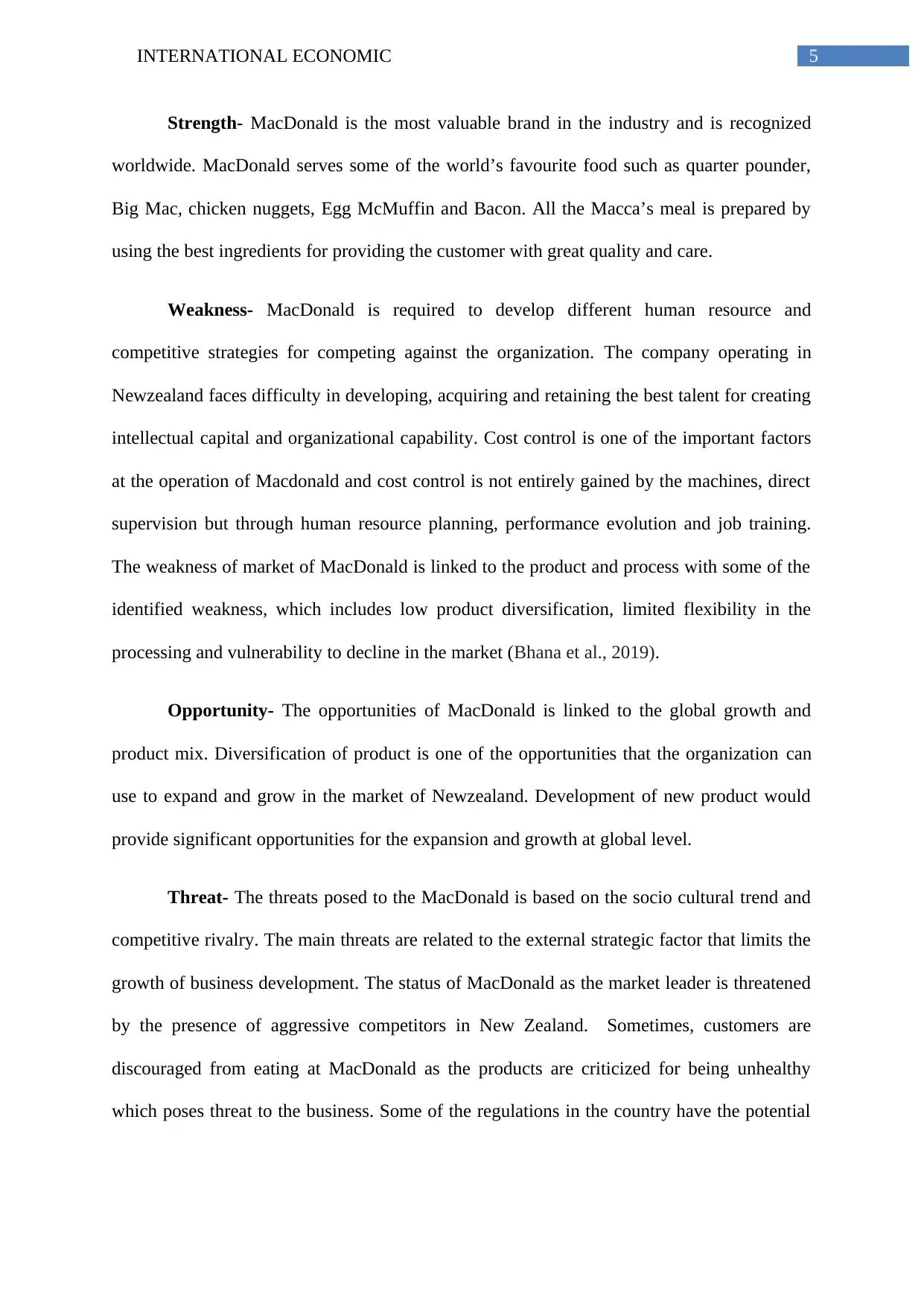
5INTERNATIONAL ECONOMIC
Strength- MacDonald is the most valuable brand in the industry and is recognized
worldwide. MacDonald serves some of the world’s favourite food such as quarter pounder,
Big Mac, chicken nuggets, Egg McMuffin and Bacon. All the Macca’s meal is prepared by
using the best ingredients for providing the customer with great quality and care.
Weakness- MacDonald is required to develop different human resource and
competitive strategies for competing against the organization. The company operating in
Newzealand faces difficulty in developing, acquiring and retaining the best talent for creating
intellectual capital and organizational capability. Cost control is one of the important factors
at the operation of Macdonald and cost control is not entirely gained by the machines, direct
supervision but through human resource planning, performance evolution and job training.
The weakness of market of MacDonald is linked to the product and process with some of the
identified weakness, which includes low product diversification, limited flexibility in the
processing and vulnerability to decline in the market (Bhana et al., 2019).
Opportunity- The opportunities of MacDonald is linked to the global growth and
product mix. Diversification of product is one of the opportunities that the organization can
use to expand and grow in the market of Newzealand. Development of new product would
provide significant opportunities for the expansion and growth at global level.
Threat- The threats posed to the MacDonald is based on the socio cultural trend and
competitive rivalry. The main threats are related to the external strategic factor that limits the
growth of business development. The status of MacDonald as the market leader is threatened
by the presence of aggressive competitors in New Zealand. Sometimes, customers are
discouraged from eating at MacDonald as the products are criticized for being unhealthy
which poses threat to the business. Some of the regulations in the country have the potential
Strength- MacDonald is the most valuable brand in the industry and is recognized
worldwide. MacDonald serves some of the world’s favourite food such as quarter pounder,
Big Mac, chicken nuggets, Egg McMuffin and Bacon. All the Macca’s meal is prepared by
using the best ingredients for providing the customer with great quality and care.
Weakness- MacDonald is required to develop different human resource and
competitive strategies for competing against the organization. The company operating in
Newzealand faces difficulty in developing, acquiring and retaining the best talent for creating
intellectual capital and organizational capability. Cost control is one of the important factors
at the operation of Macdonald and cost control is not entirely gained by the machines, direct
supervision but through human resource planning, performance evolution and job training.
The weakness of market of MacDonald is linked to the product and process with some of the
identified weakness, which includes low product diversification, limited flexibility in the
processing and vulnerability to decline in the market (Bhana et al., 2019).
Opportunity- The opportunities of MacDonald is linked to the global growth and
product mix. Diversification of product is one of the opportunities that the organization can
use to expand and grow in the market of Newzealand. Development of new product would
provide significant opportunities for the expansion and growth at global level.
Threat- The threats posed to the MacDonald is based on the socio cultural trend and
competitive rivalry. The main threats are related to the external strategic factor that limits the
growth of business development. The status of MacDonald as the market leader is threatened
by the presence of aggressive competitors in New Zealand. Sometimes, customers are
discouraged from eating at MacDonald as the products are criticized for being unhealthy
which poses threat to the business. Some of the regulations in the country have the potential
You're viewing a preview
Unlock full access by subscribing today!
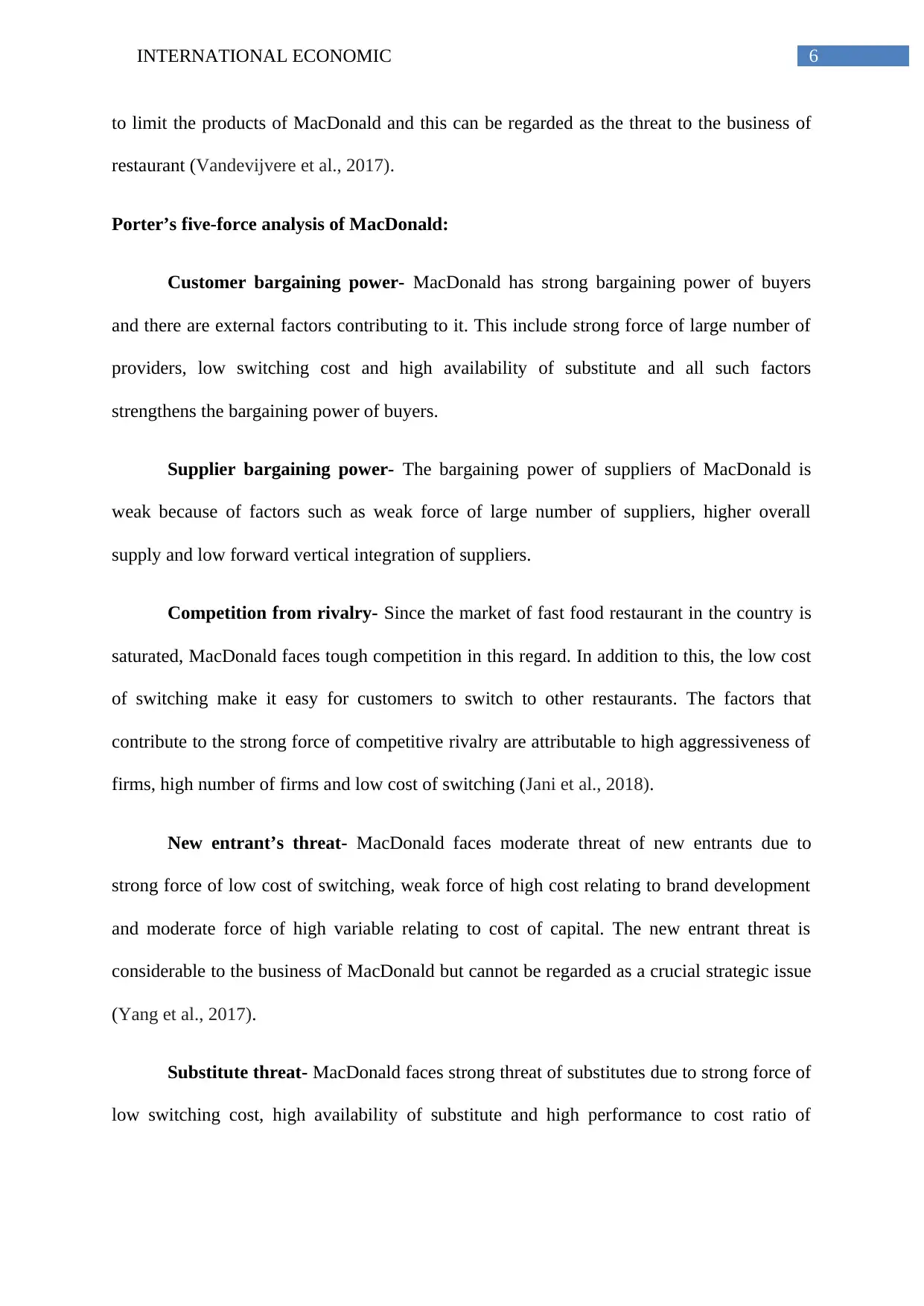
6INTERNATIONAL ECONOMIC
to limit the products of MacDonald and this can be regarded as the threat to the business of
restaurant (Vandevijvere et al., 2017).
Porter’s five-force analysis of MacDonald:
Customer bargaining power- MacDonald has strong bargaining power of buyers
and there are external factors contributing to it. This include strong force of large number of
providers, low switching cost and high availability of substitute and all such factors
strengthens the bargaining power of buyers.
Supplier bargaining power- The bargaining power of suppliers of MacDonald is
weak because of factors such as weak force of large number of suppliers, higher overall
supply and low forward vertical integration of suppliers.
Competition from rivalry- Since the market of fast food restaurant in the country is
saturated, MacDonald faces tough competition in this regard. In addition to this, the low cost
of switching make it easy for customers to switch to other restaurants. The factors that
contribute to the strong force of competitive rivalry are attributable to high aggressiveness of
firms, high number of firms and low cost of switching (Jani et al., 2018).
New entrant’s threat- MacDonald faces moderate threat of new entrants due to
strong force of low cost of switching, weak force of high cost relating to brand development
and moderate force of high variable relating to cost of capital. The new entrant threat is
considerable to the business of MacDonald but cannot be regarded as a crucial strategic issue
(Yang et al., 2017).
Substitute threat- MacDonald faces strong threat of substitutes due to strong force of
low switching cost, high availability of substitute and high performance to cost ratio of
to limit the products of MacDonald and this can be regarded as the threat to the business of
restaurant (Vandevijvere et al., 2017).
Porter’s five-force analysis of MacDonald:
Customer bargaining power- MacDonald has strong bargaining power of buyers
and there are external factors contributing to it. This include strong force of large number of
providers, low switching cost and high availability of substitute and all such factors
strengthens the bargaining power of buyers.
Supplier bargaining power- The bargaining power of suppliers of MacDonald is
weak because of factors such as weak force of large number of suppliers, higher overall
supply and low forward vertical integration of suppliers.
Competition from rivalry- Since the market of fast food restaurant in the country is
saturated, MacDonald faces tough competition in this regard. In addition to this, the low cost
of switching make it easy for customers to switch to other restaurants. The factors that
contribute to the strong force of competitive rivalry are attributable to high aggressiveness of
firms, high number of firms and low cost of switching (Jani et al., 2018).
New entrant’s threat- MacDonald faces moderate threat of new entrants due to
strong force of low cost of switching, weak force of high cost relating to brand development
and moderate force of high variable relating to cost of capital. The new entrant threat is
considerable to the business of MacDonald but cannot be regarded as a crucial strategic issue
(Yang et al., 2017).
Substitute threat- MacDonald faces strong threat of substitutes due to strong force of
low switching cost, high availability of substitute and high performance to cost ratio of
Paraphrase This Document
Need a fresh take? Get an instant paraphrase of this document with our AI Paraphraser
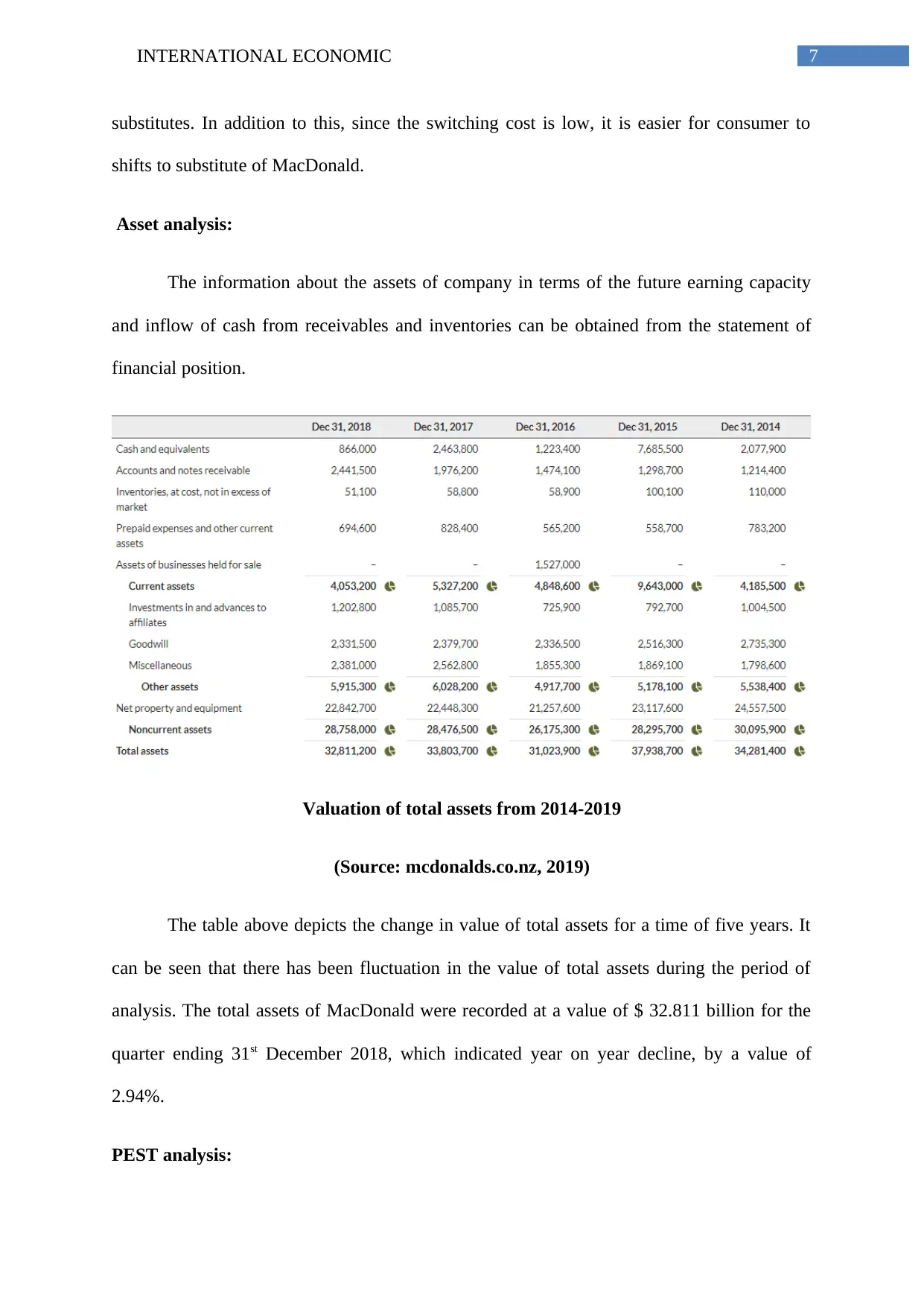
7INTERNATIONAL ECONOMIC
substitutes. In addition to this, since the switching cost is low, it is easier for consumer to
shifts to substitute of MacDonald.
Asset analysis:
The information about the assets of company in terms of the future earning capacity
and inflow of cash from receivables and inventories can be obtained from the statement of
financial position.
Valuation of total assets from 2014-2019
(Source: mcdonalds.co.nz, 2019)
The table above depicts the change in value of total assets for a time of five years. It
can be seen that there has been fluctuation in the value of total assets during the period of
analysis. The total assets of MacDonald were recorded at a value of $ 32.811 billion for the
quarter ending 31st December 2018, which indicated year on year decline, by a value of
2.94%.
PEST analysis:
substitutes. In addition to this, since the switching cost is low, it is easier for consumer to
shifts to substitute of MacDonald.
Asset analysis:
The information about the assets of company in terms of the future earning capacity
and inflow of cash from receivables and inventories can be obtained from the statement of
financial position.
Valuation of total assets from 2014-2019
(Source: mcdonalds.co.nz, 2019)
The table above depicts the change in value of total assets for a time of five years. It
can be seen that there has been fluctuation in the value of total assets during the period of
analysis. The total assets of MacDonald were recorded at a value of $ 32.811 billion for the
quarter ending 31st December 2018, which indicated year on year decline, by a value of
2.94%.
PEST analysis:
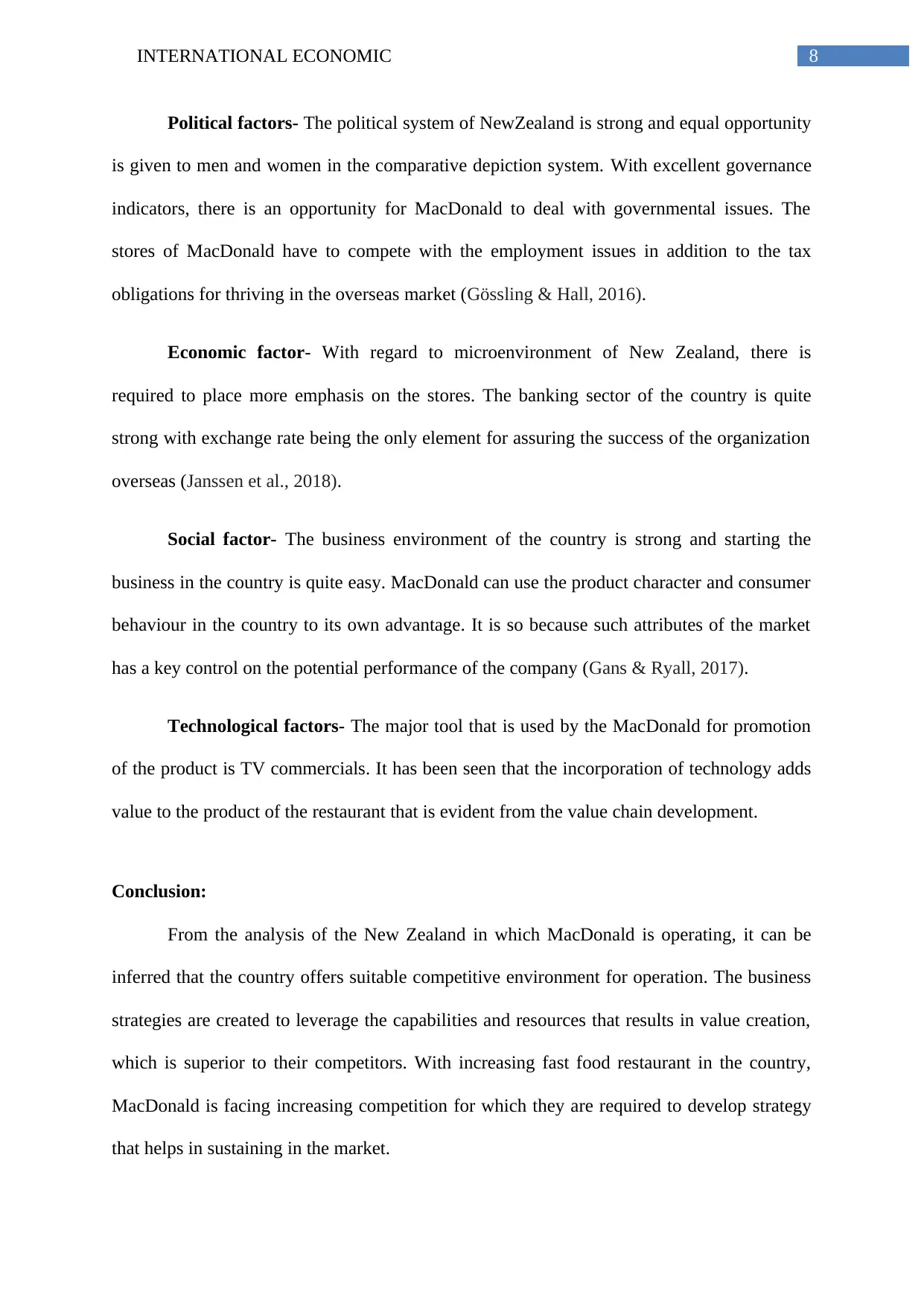
8INTERNATIONAL ECONOMIC
Political factors- The political system of NewZealand is strong and equal opportunity
is given to men and women in the comparative depiction system. With excellent governance
indicators, there is an opportunity for MacDonald to deal with governmental issues. The
stores of MacDonald have to compete with the employment issues in addition to the tax
obligations for thriving in the overseas market (Gössling & Hall, 2016).
Economic factor- With regard to microenvironment of New Zealand, there is
required to place more emphasis on the stores. The banking sector of the country is quite
strong with exchange rate being the only element for assuring the success of the organization
overseas (Janssen et al., 2018).
Social factor- The business environment of the country is strong and starting the
business in the country is quite easy. MacDonald can use the product character and consumer
behaviour in the country to its own advantage. It is so because such attributes of the market
has a key control on the potential performance of the company (Gans & Ryall, 2017).
Technological factors- The major tool that is used by the MacDonald for promotion
of the product is TV commercials. It has been seen that the incorporation of technology adds
value to the product of the restaurant that is evident from the value chain development.
Conclusion:
From the analysis of the New Zealand in which MacDonald is operating, it can be
inferred that the country offers suitable competitive environment for operation. The business
strategies are created to leverage the capabilities and resources that results in value creation,
which is superior to their competitors. With increasing fast food restaurant in the country,
MacDonald is facing increasing competition for which they are required to develop strategy
that helps in sustaining in the market.
Political factors- The political system of NewZealand is strong and equal opportunity
is given to men and women in the comparative depiction system. With excellent governance
indicators, there is an opportunity for MacDonald to deal with governmental issues. The
stores of MacDonald have to compete with the employment issues in addition to the tax
obligations for thriving in the overseas market (Gössling & Hall, 2016).
Economic factor- With regard to microenvironment of New Zealand, there is
required to place more emphasis on the stores. The banking sector of the country is quite
strong with exchange rate being the only element for assuring the success of the organization
overseas (Janssen et al., 2018).
Social factor- The business environment of the country is strong and starting the
business in the country is quite easy. MacDonald can use the product character and consumer
behaviour in the country to its own advantage. It is so because such attributes of the market
has a key control on the potential performance of the company (Gans & Ryall, 2017).
Technological factors- The major tool that is used by the MacDonald for promotion
of the product is TV commercials. It has been seen that the incorporation of technology adds
value to the product of the restaurant that is evident from the value chain development.
Conclusion:
From the analysis of the New Zealand in which MacDonald is operating, it can be
inferred that the country offers suitable competitive environment for operation. The business
strategies are created to leverage the capabilities and resources that results in value creation,
which is superior to their competitors. With increasing fast food restaurant in the country,
MacDonald is facing increasing competition for which they are required to develop strategy
that helps in sustaining in the market.
You're viewing a preview
Unlock full access by subscribing today!
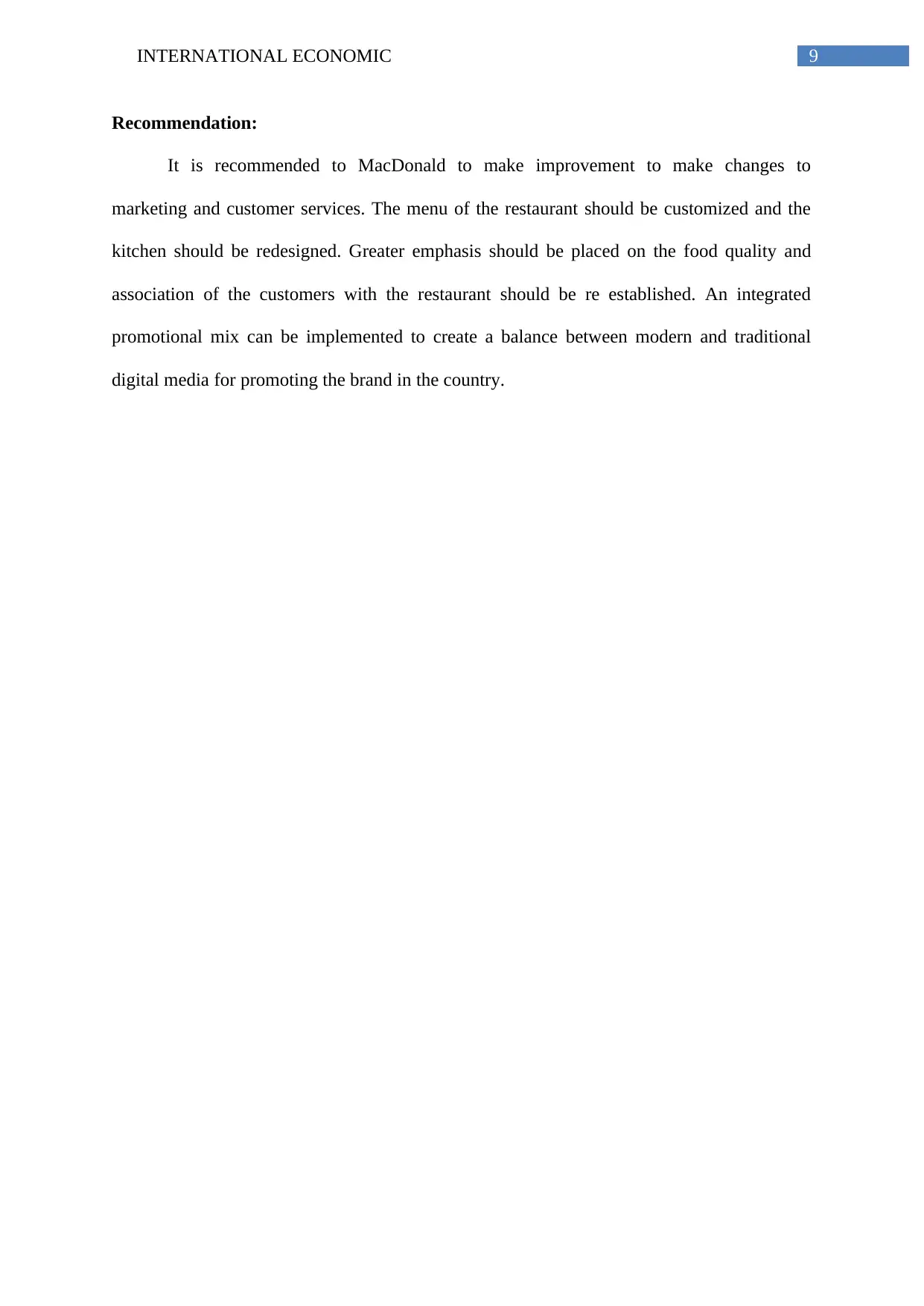
9INTERNATIONAL ECONOMIC
Recommendation:
It is recommended to MacDonald to make improvement to make changes to
marketing and customer services. The menu of the restaurant should be customized and the
kitchen should be redesigned. Greater emphasis should be placed on the food quality and
association of the customers with the restaurant should be re established. An integrated
promotional mix can be implemented to create a balance between modern and traditional
digital media for promoting the brand in the country.
Recommendation:
It is recommended to MacDonald to make improvement to make changes to
marketing and customer services. The menu of the restaurant should be customized and the
kitchen should be redesigned. Greater emphasis should be placed on the food quality and
association of the customers with the restaurant should be re established. An integrated
promotional mix can be implemented to create a balance between modern and traditional
digital media for promoting the brand in the country.
Paraphrase This Document
Need a fresh take? Get an instant paraphrase of this document with our AI Paraphraser
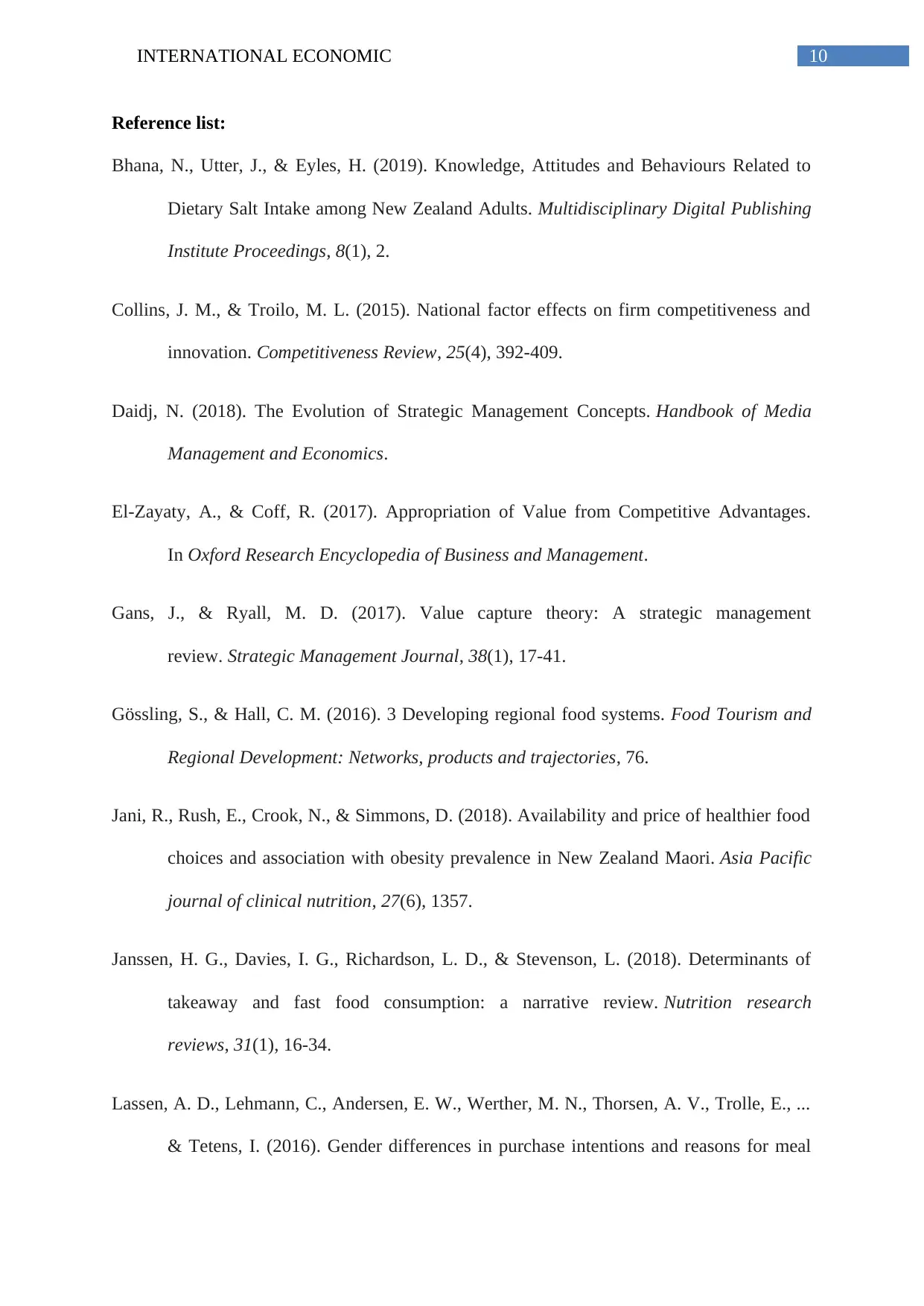
10INTERNATIONAL ECONOMIC
Reference list:
Bhana, N., Utter, J., & Eyles, H. (2019). Knowledge, Attitudes and Behaviours Related to
Dietary Salt Intake among New Zealand Adults. Multidisciplinary Digital Publishing
Institute Proceedings, 8(1), 2.
Collins, J. M., & Troilo, M. L. (2015). National factor effects on firm competitiveness and
innovation. Competitiveness Review, 25(4), 392-409.
Daidj, N. (2018). The Evolution of Strategic Management Concepts. Handbook of Media
Management and Economics.
El-Zayaty, A., & Coff, R. (2017). Appropriation of Value from Competitive Advantages.
In Oxford Research Encyclopedia of Business and Management.
Gans, J., & Ryall, M. D. (2017). Value capture theory: A strategic management
review. Strategic Management Journal, 38(1), 17-41.
Gössling, S., & Hall, C. M. (2016). 3 Developing regional food systems. Food Tourism and
Regional Development: Networks, products and trajectories, 76.
Jani, R., Rush, E., Crook, N., & Simmons, D. (2018). Availability and price of healthier food
choices and association with obesity prevalence in New Zealand Maori. Asia Pacific
journal of clinical nutrition, 27(6), 1357.
Janssen, H. G., Davies, I. G., Richardson, L. D., & Stevenson, L. (2018). Determinants of
takeaway and fast food consumption: a narrative review. Nutrition research
reviews, 31(1), 16-34.
Lassen, A. D., Lehmann, C., Andersen, E. W., Werther, M. N., Thorsen, A. V., Trolle, E., ...
& Tetens, I. (2016). Gender differences in purchase intentions and reasons for meal
Reference list:
Bhana, N., Utter, J., & Eyles, H. (2019). Knowledge, Attitudes and Behaviours Related to
Dietary Salt Intake among New Zealand Adults. Multidisciplinary Digital Publishing
Institute Proceedings, 8(1), 2.
Collins, J. M., & Troilo, M. L. (2015). National factor effects on firm competitiveness and
innovation. Competitiveness Review, 25(4), 392-409.
Daidj, N. (2018). The Evolution of Strategic Management Concepts. Handbook of Media
Management and Economics.
El-Zayaty, A., & Coff, R. (2017). Appropriation of Value from Competitive Advantages.
In Oxford Research Encyclopedia of Business and Management.
Gans, J., & Ryall, M. D. (2017). Value capture theory: A strategic management
review. Strategic Management Journal, 38(1), 17-41.
Gössling, S., & Hall, C. M. (2016). 3 Developing regional food systems. Food Tourism and
Regional Development: Networks, products and trajectories, 76.
Jani, R., Rush, E., Crook, N., & Simmons, D. (2018). Availability and price of healthier food
choices and association with obesity prevalence in New Zealand Maori. Asia Pacific
journal of clinical nutrition, 27(6), 1357.
Janssen, H. G., Davies, I. G., Richardson, L. D., & Stevenson, L. (2018). Determinants of
takeaway and fast food consumption: a narrative review. Nutrition research
reviews, 31(1), 16-34.
Lassen, A. D., Lehmann, C., Andersen, E. W., Werther, M. N., Thorsen, A. V., Trolle, E., ...
& Tetens, I. (2016). Gender differences in purchase intentions and reasons for meal
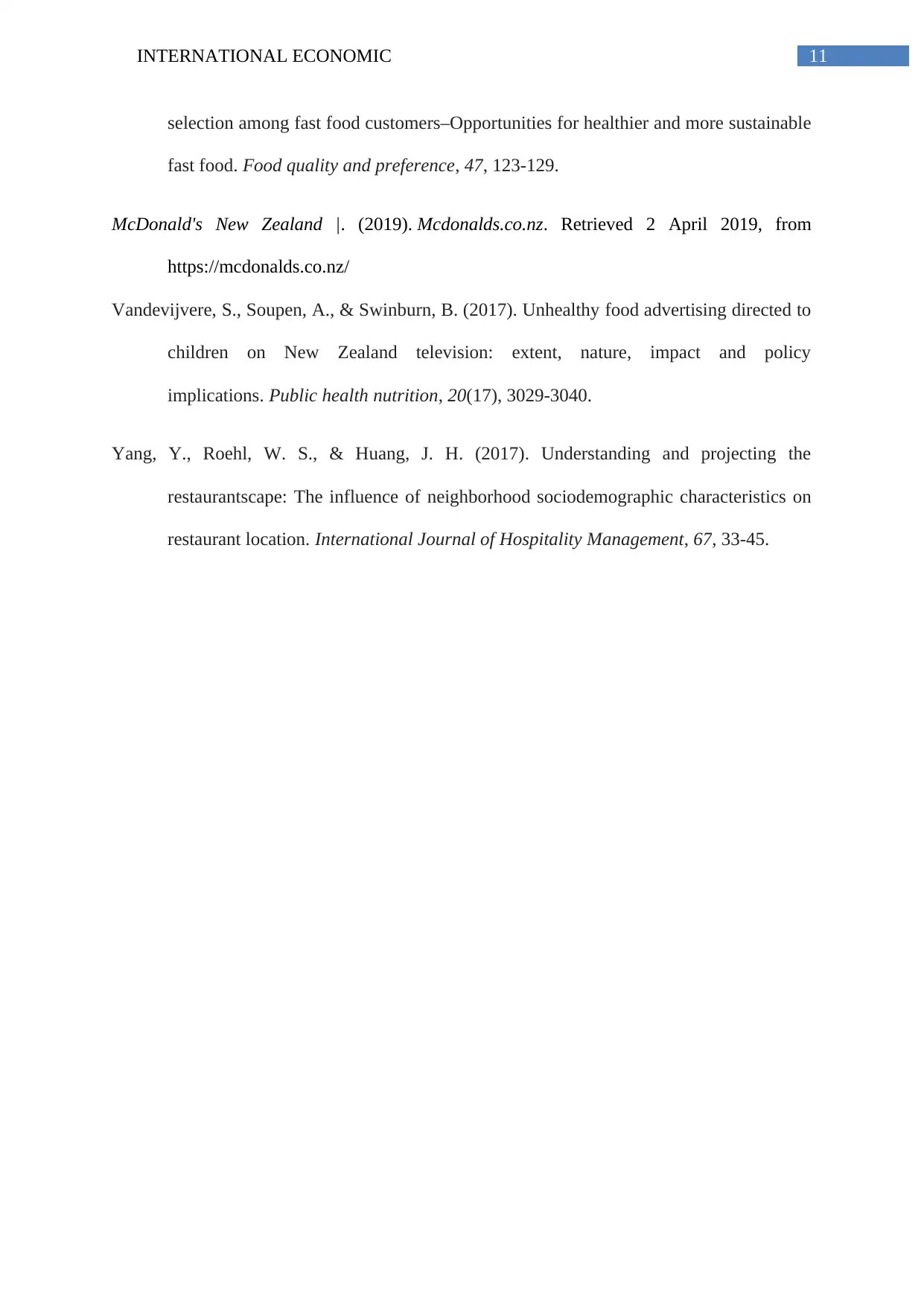
11INTERNATIONAL ECONOMIC
selection among fast food customers–Opportunities for healthier and more sustainable
fast food. Food quality and preference, 47, 123-129.
McDonald's New Zealand |. (2019). Mcdonalds.co.nz. Retrieved 2 April 2019, from
https://mcdonalds.co.nz/
Vandevijvere, S., Soupen, A., & Swinburn, B. (2017). Unhealthy food advertising directed to
children on New Zealand television: extent, nature, impact and policy
implications. Public health nutrition, 20(17), 3029-3040.
Yang, Y., Roehl, W. S., & Huang, J. H. (2017). Understanding and projecting the
restaurantscape: The influence of neighborhood sociodemographic characteristics on
restaurant location. International Journal of Hospitality Management, 67, 33-45.
selection among fast food customers–Opportunities for healthier and more sustainable
fast food. Food quality and preference, 47, 123-129.
McDonald's New Zealand |. (2019). Mcdonalds.co.nz. Retrieved 2 April 2019, from
https://mcdonalds.co.nz/
Vandevijvere, S., Soupen, A., & Swinburn, B. (2017). Unhealthy food advertising directed to
children on New Zealand television: extent, nature, impact and policy
implications. Public health nutrition, 20(17), 3029-3040.
Yang, Y., Roehl, W. S., & Huang, J. H. (2017). Understanding and projecting the
restaurantscape: The influence of neighborhood sociodemographic characteristics on
restaurant location. International Journal of Hospitality Management, 67, 33-45.
You're viewing a preview
Unlock full access by subscribing today!
1 out of 12
Related Documents
Your All-in-One AI-Powered Toolkit for Academic Success.
+13062052269
info@desklib.com
Available 24*7 on WhatsApp / Email
![[object Object]](/_next/static/media/star-bottom.7253800d.svg)
Unlock your academic potential
© 2024 | Zucol Services PVT LTD | All rights reserved.





